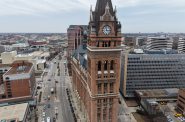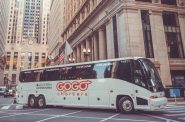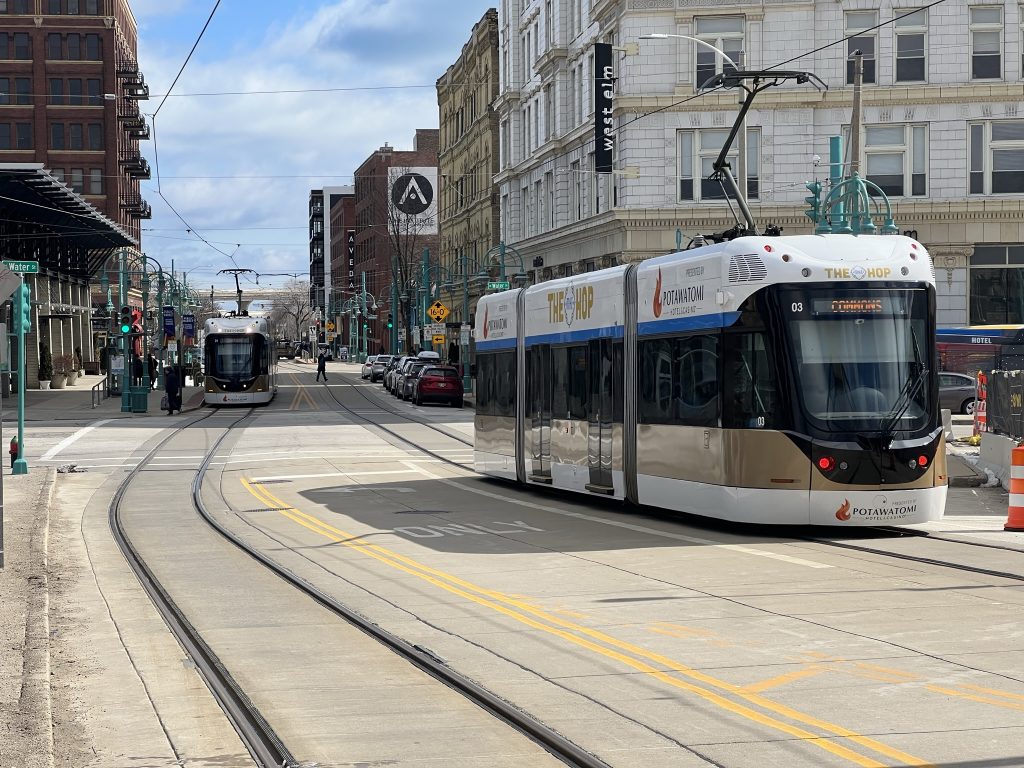One Alderman’s Quest To Defund The Streetcar
Ald. Scott Spiker wants city to hop off The Hop.
Alderman Scott Spiker isn’t happy with the state of, or the outlook for, Milwaukee’s streetcar system, The Hop.
Calling it “good money after bad,” he’s asking his colleagues to consider defunding the system.
“You have a loop that goes two miles and no prospect for expanding it,” Spiker said Oct. 16 during a Finance & Personnel Committee budget hearing..
Act 12, the 2023 sales tax legislation, includes restrictions on using property tax revenue to fund the system’s expansion. Spiker said using $4.2 million in parking revenue and $2.7 million in sponsorship and grant revenue to cover the system’s $6.9 million operating cost is irresponsible.
The streetcar, he argued, is “largely a device for transporting the unhoused and the well-heeled.”
But Mayor Cavalier Johnson‘s administration isn’t ready to give up. Department of Public Works Commissioner Jerrel Kruschke said future elections could result in Act 12 being amended or federal support for expansion.
Shutting it down could also trigger a demand from the Federal Transit Administration to return a prorated portion of the nearly $70 million in federal funds that helped build the system.
“That’s a $48 million check we would need to cut tomorrow,” said Kruschke. The city, he added, committed to 25 years of vehicle operation and 40 years of infrastructure maintenance.
But that might not be the biggest issue, he warned.
“If we decided to shut that down, we would basically eliminate ourselves from getting any FTA funding in the future. Period. It’s a black eye,” he said.
Spiker said President Donald Trump and Transportation Secretary Sean Duffy, a former Wisconsin congressman, are no fans of mass transit and might not ask for the money back.
Kruschke said he didn’t believe that was true, noting that the Trump administration previously rescinded a $30 million grant to rebuild N. 6th Street. “Yes, they could claw it back and I assume they would,” he said.
Spiker’s colleagues also didn’t appear swayed by his arguments.
“The Milwaukee streetcar is not a drain on city resources,” said Ald. Peter Burgelis. “It’s a strategic investment that strengthens the downtown economy, it raises property values downtown and it helps reduce the tax burden on homeowners in every area of the city.”
A press release issued after the meeting by Burgelis and leading streetcar advocate Ald. Robert Bauman said property values near the line grew 16.5% last year, outpacing the 15% citywide increase. The stronger growth shifts more of the tax burden to Downtown.
“It’s not a subsidy. It’s a strategy that pays off for the entire city,” said Burgelis.
“It’s about vision. It’s also about hope,” said Ald. Marina Dimtrijevic, who said she’s committed to investing in alternatives to motor vehicles. Kruschke said 40% of system riders, based on a third-party survey, don’t have motor vehicles. “I always want to invest in scooters, bicycle lanes, anything that is not car centric.”
“The streetcar does provide vitality to Downtown,” said Ald. Mark Chambers, Jr. He said he wants it expanded.
Council members Sharlen P. Moore and Milele A. Coggs asked Kruschke and the budget office for more data and to explore ways to make fare collection possible.
“On a small system, it is not effective,” said Kruschke of fare collection. He said the marginal revenue gain would be offset by staffing costs to collect the fare and a less desirable experience. Coggs said DPW should explore ways to use technology to collect fares without staffing.
Coggs, one of the few council members remaining from the system’s 2015 approval, said she supported it based on the belief it would someday extend to Bronzeville.
Spiker wasn’t moved by his colleague’s arguments.
He said the idea that Downtown was thriving because of the streetcar “laughable.”
“The only good argument I hear for keeping it is that if we stop, we’ll owe someone money,” he said.
He encouraged Kruschke to get an answer from the FTA on what repayment would actually be owed and thanked his colleagues for discussing the issue.
For several years, Spiker has made his disdain for the streetcar clear. First elected in 2019, he didn’t get to vote on the system’s creation, but he has voted against studying its expansion and previously supported defunding the line.
Quick takeaways
- The city has hired a new streetcar manager, James Vineau. A dual U.S. and French citizen, Vineau helped build a tram system in Qatar and previously worked for international transit operator RATP Dev.
- The 2026 budget calls for almost $1 million more in streetcar-related revenue. Kruschke said the city would be working more aggressively to yield sponsorship revenue and has seen interest.
- Potawatomi Hotel & Casino continues to be the presenting sponsor as part of a 12-year agreement, $10 million.
- Operating costs are budgeted to grow 18% year over year. The city contracts with Transdev to operate the system.
- The system’s annual ridership is expected to decline year-over-year for the first time since the pandemic, falling from 532,460 (1,455 per day) to 490,000 (1,342). However, the system just recorded its best August and September since the on-set of the pandemic.
If you think stories like this are important, become a member of Urban Milwaukee and help support real, independent journalism. Plus you get some cool added benefits.
More about the 2026 Milwaukee Budget
- When Democracy Delivers an Answer You Don’t Like, You Don’t Get to Redefine Democracy - Ald. Peter Burgelis - Dec 13th, 2025
- Entire Council Overrides Every Budget Veto by Mayor Johnson - Jeramey Jannene - Nov 25th, 2025
- Op Ed: Why the Common Council’s Amended Budget is Good Policy for Milwaukee - Alds. Marina Dimitrijevic and Russell W. Stamper, II - Nov 20th, 2025
- Milwaukee DSA Calls on Common Council to Overrule Mayor’s Veto of 4% Worker Raises - Milwaukee Democratic Socialists of America - Nov 20th, 2025
- Miffed Mayor Issues 7 Budget Vetoes - Jeramey Jannene - Nov 18th, 2025
- What’s In the 44 Footnotes Added to Milwaukee’s Budget? - Jeramey Jannene - Nov 14th, 2025
- Common Council adopts amended 2026 City budget - Ald. Marina Dimitrijevic - Nov 7th, 2025
- Council Marks Up Mayor’s 2026 Budget, Adds Services, Pay Raises - Jeramey Jannene - Nov 7th, 2025
- Committee Amends 2026 City Budget, Prioritizes Neighborhood Investment Citywide - Ald. Marina Dimitrijevic - Nov 3rd, 2025
- City Hall: Council Spends More Than Nine Hours Debating Budget Amendments - Jeramey Jannene - Oct 31st, 2025
Read more about 2026 Milwaukee Budget here
More about the Milwaukee Streetcar
For more project details, including the project timeline, financing, route and possible extensions, see our extensive past coverage.
- FTA Tells Milwaukee to Crack Down on Fare Evasion — Even Where Fares Don’t Exist - Graham Kilmer - Dec 12th, 2025
- Alderman, State Allies Seek Federal Help to Kill the Streetcar - Jeramey Jannene - Oct 28th, 2025
- Streetcar Service Suspended Following Truck Crash - Jeramey Jannene - Oct 21st, 2025
- One Alderman’s Quest To Defund The Streetcar - Jeramey Jannene - Oct 18th, 2025
- Another Streetcar Collision - Jeramey Jannene - Jun 27th, 2025
- Streetcar Hit By Apparent Red Light Runner - Jeramey Jannene - Jun 16th, 2025
- Streetcar Will Run On Consolidated Route During Summerfest - Jeramey Jannene - Jun 11th, 2025
- City Hall: Milwaukee Must Replace Failing Streetcar Switches - Jeramey Jannene - Feb 24th, 2025
- Streetcar Confronts Limited Funding, Operations Challenges - Evan Casey - Jan 22nd, 2025
- Council Kills Streetcar’s ‘Festivals Line’ - Jeramey Jannene - Jul 31st, 2024
Read more about Milwaukee Streetcar here
Political Contributions Tracker
Displaying political contributions between people mentioned in this story. Learn more.
- March 4, 2016 - Cavalier Johnson received $35 from Sharlen P. Moore
- February 20, 2016 - Cavalier Johnson received $250 from Robert Bauman
City Hall
-
Council Blocked In Fight To Oversee Top City Officials
 Dec 16th, 2025 by Jeramey Jannene
Dec 16th, 2025 by Jeramey Jannene
-
Latest Effort to Adopt New Milwaukee Flag Going Nowhere
 Dec 3rd, 2025 by Jeramey Jannene
Dec 3rd, 2025 by Jeramey Jannene
-
After Deadly May Fire, Milwaukee Adds New Safety Requirements
 Dec 2nd, 2025 by Jeramey Jannene
Dec 2nd, 2025 by Jeramey Jannene
Transportation
-
Congestion Pricing Cuts Air Pollution in New York City
 Dec 14th, 2025 by Jeff Wood
Dec 14th, 2025 by Jeff Wood
-
FTA Tells Milwaukee to Crack Down on Fare Evasion — Even Where Fares Don’t Exist
 Dec 12th, 2025 by Graham Kilmer
Dec 12th, 2025 by Graham Kilmer
-
Will GOGO’s Bus Service Ever Get Going?
 Dec 9th, 2025 by Jeramey Jannene
Dec 9th, 2025 by Jeramey Jannene























There are conservatives in Southeast Wisconsin who have complained about the streetcar since before it was approved and fought it tooth and nail. Does Scott receive “support” from some of these folks, thus pushing their agenda versus supporting the folks who live in Milwaukee and use the streetcar, constantly?
There has been significant development within one block of the streetcar line, and even more significant development within two blocks of the streetcar line since it was announced to be going in.
Trump and Duffy will not allow Milwaukee off the hook on the money if Milwaukee shuts it down. Even if they say they would, we all know they lie about everything, especially when it comes to money and punishing blue cities, in blue states, with non-white mayors. Trump can never, never be trusted.
So, is Scott willing to let us know who his “constituents” are who are demanding the shutdown of the streetcar? He should get on board with expanding the streetcar – it would be positive for the city. If Scott had come to the No Kings protest today, he would have seen thousands of people using the streetcar.
What was Terry Witkowski’s stand on the streetcar, and why does Scott have a different stance? Have the constituencies changed?
And whatever happened to the idea to begin light rail between the city and the suburbs? When Mark Borkowski was one of the leaders fighting against the streetcar, he stated that we should start light rail, that the cost would be manageable since the rail right-of-ways already existed to several of the suburbs. Haven’t heard anything on that since the streetcar was approved. Interesting.
The Hop is a fiscal disaster, Tom Barrett screwed the taxpayers of MKE.
Spiker is right the Hop should be shut down, the big hang up is the $$$ owed to the federal government for shutting it down.
Shut down the Hop!!!
Given how the streetcar is always a target of the right wing, I think he’s just pandering to that crowd. I thought he was more civic minded than that, but I guess not. Maybe he should follow Bob Donovan and move to Greenfield.
To anyone ….. Fill in the blanks, please. “There has been significant development within one block (and even more within two blocks} of the streetcar line” that would likely not have happened were there no streetcar, specifically: _________________________________________________________
The evidence that such development was/is at least partially influenced by the streetcar line starting up includes the following _________________________.
Thank you.
I created a file examining the relationship between streetcars and development:
https://johndecember.com/places/mke/streetcar/development.html
It’s wonderful to see this discussion. And thanks John December for the streetcar article.
Regarding filling in the blanks, the first question is easy, the second not as much, since press releases and TV news stories are not easily accessible. Several developers did mention the streetcar line as a factor in their projects. Granted some folks might nitpick a couple of these projects, and those projects may have happened without the streetcar advantage, but we’ll never know about each of them for sure.
However, a major portion of these developments were planned or executed during the Covid pandemic, which makes it even more impressive. So here is a beginning of a list at a glance:
Foxtown Landing Taproom, Distillery, Restaurant
MKE Dog Park
333 Water apartment building
300 N Broadway block – restaurant and retail redevelopment
The Electric Apartments
Huron building with the Tupelo Honey restaurant
Ascent Tower
Nova
St. Rita’s Square Sr. Community
Street Car Flats
Milwaukee Athletic Club
BMO Harris Office Building
The Kinn Hotel
Quadracci rehab
The Couture
Hilton Hotels on Jefferson
Central Standard Crafthouse
Other:
7SEVENTY7 – NML had voiced support for the streetcar line during time they planned this
Pfister – updated
Hotel Metro – updated
St. Kate Hotel – updated
Significant Retail and Restaurant growth along the line
I forgot to mention that John December’s linked article goes deeper in the footnotes on additional projects and backstories.
Please read it!
Thanks for the effort and data seeking evidence of a connection between the streetcar and relevant development. As for the various studies about potential impacts in non-Milwaukee metropolitan settings, I don’t consider them particularly helpful. It’s Milwaukee’s geographic variables, roadways, and demographics and usage patterns we are dealing with here.
I find it interesting and disappointing that we seem not to have a commentary in which those responsible for construction, expansion, upgrading/improvement of actual real property have been interviewed about their decisions and the role of the streetcar influencing their organizations’ commitments. If I were a researcher on this topic that would be my primary technique and focus …. a question and interview approach.
As one who’s lived in metro/urban Chicago (frequent public transport user there) and metro/urban Milwaukee (living exactly next to the HOP tracks and station) I would never use either one of them as instructive about both cities transportation issues and opportunities. Difference worlds.
I’m a proponent of mass transit and of The Hop. Suffice it to say that a lot has changed since The Hop was approved in 2015, and things have definitely not gone as planned.
Those who are saying “I told you so” are those who were never for it, supported any roadblock that could be put in The Hop’s way, and cheered every headwind The Hop experienced.
I regard this current conversation as a call to come together to answer the question, “What next?” Frankly, I hold a middle space between Spiker who seems to want to cut bait and Burgelis and others who throw out terms like “a strategy that pays off for the entire city, and “it’s about vision and hope.” Neither extreme is helpful in (1) being clear and (2) looking at current reality and considering next steps.
COSTS:
Good to have a more clarity on how the costs for The Hop are currently covered and a bit more about the potential costs of say, doing away with it.
We need more clarity on this. Everyone agrees that money isn’t falling from trees these days.
VALUE OF THE HOP:
The Hop’s ultimate value has always been about its expansion, not on its current “starter system.” It was never meant to be simply an investment in the downtown economy. If the City were able to fund and build into Bronzeville, the South Side, East Side, and even west, the question of value would not be a question. Unfortunately, the landscape for expansion funding has changed significantly. (See below.) It is disingenuous to judge the starter system outside of its larger goals and purpose.
It is easy to say that The Hop (and other streetcar systems) encourage development and raise property values/taxes. Easier said than demonstrated. Coincidence is NOT causality and, just because something is developed within 3 blocks of The Hop or someone “voices support” for it in no way means The Hop caused the development or was even a a significant consideration. It snakes through downtown to such an extent that its easy to argue the point without actually having to isolate The Hop as a significant factor. There are myriad other factors that determine where something is developed. (The only developers I recall to cite The Hop as a factor were those of 333 Water Street. And, I am convinced they did so at a press conference at the behest of city officials.)
EXPANSION FUNDING:
Since approval and significant funding through local TIFs and federal funding, much has changed.
The Hop, for better or worse, became linked to the Couture development midway through that decade-long “process” as a replacement for old bus terminal on the site. A federal grant went unused for years after many Couture delays and a subsequent TIGER grant application was denied because MKE was not viewed as a reliable funding recipient. It was holding onto an unused years-old grant.
“Wisconsin Act 12, signed into law in 2023, said Milwaukee cannot use “moneys raised by levying taxes for … developing, operating, or maintaining” the streetcar. It also says the city cannot use a tax incremental financing district for “direct or indirect expenses related to developing, constructing, or operating” the streetcar.” (WPR article by Evan Casey, 1/22/2025)
Good luck getting any federal funding for this in at least the next 4 years.
“EXPANSION” POSSIBILITIES:
First, start charging fare.
Second, market the heck out of sponsorships.
Next, given where we are for now, agree that The Hop is what it is, downtown’s streetcar system. (At least for the foreseeable future.)
Clarify Act 12 – Can someone tell me if Act 12 restricts tax and state revenue sharing in Milwaukee for “The Hop,” “urban rail systems,” or what? I can’t find this, but it is SUPER IMPORTANT in determining “What next?”
Abandon, at least for the foreseeable future, expansion of “The Hop.”
Consider available options that would be more fundable than what Act 12 allows that would leverage things like right-of-way and signal timing, all things that The Hop is supposed to do. I’m not imagining expanding from the current Hop termini along currently planned Hop expansion routes, but a valuable, sensible NEW expansion system that intersects The Hop at key points but is much cheaper and flexible.
CHEAPER, EASIER, EASILY COMPATIBLE WITH THE HOP:
A new system like this that intersects but is not The Hop or an expansion of it, is possible. MKE simply needs to reframe where it is and what is possible. What about much less expensive, Hop-intersecting routes, along Vel Phillips and 6th Street to the north; Wells Street east and west; Water Street and Prospect/Farwell Streets to the East Side; and 6th Street and 2nd Street/Plankinton to the south?
For example, I’ve been reading about Autonomous Rapid Transit (ART) systems elsewhere that allow vehicles to follow a route on a *virtual track* of sensors/markings on the roadway. Optical guidance means it approaches light rail, but is less expensive, and can also utilize vehicles with precision-docking capacity. No rails, but compatible with The Hop’s rail system at intersections and even at shared stops.
Frankly, this seems to be more the current future of urban rapid transit.
The hop needs further expansion and way more funding.
Spiker needs to GO.
Those in his district: PLEASE vote this clown out ASAP.